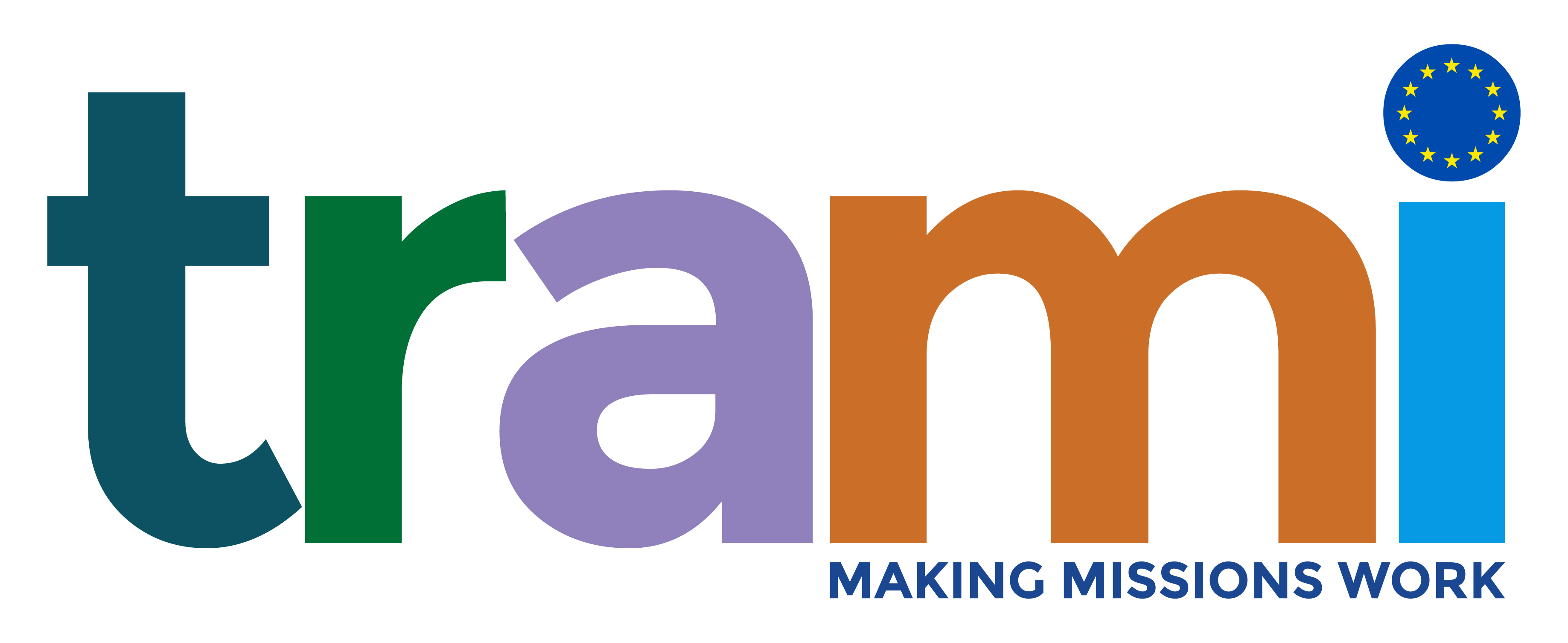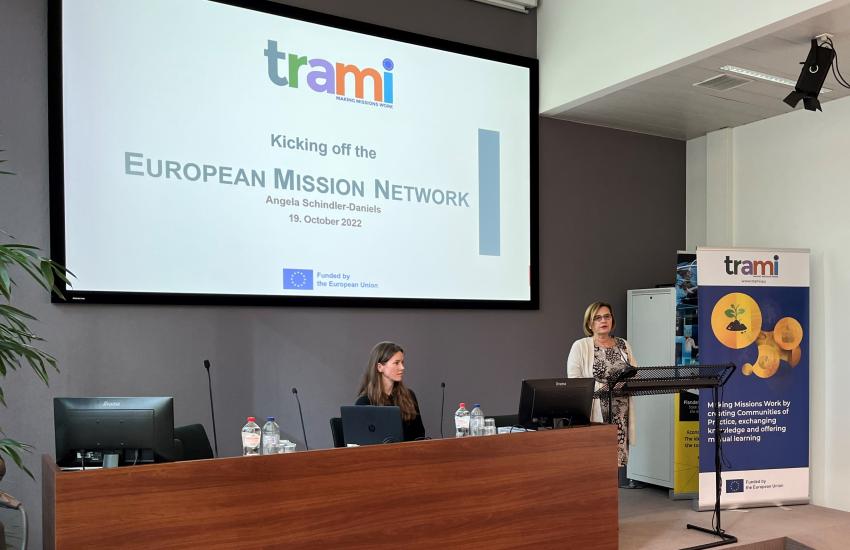EMiN Kick-off
The EMIN Kick-Off took place in-person on Wednesday the 19th of October 2022 between 9:30 – 17:30 CET in Brussels at the Flemish government - Department of Economy, Science and Innovation (EWI) (Koning Albert II Laan 35, 1030 Brussels).
Aims of the meeting
To collect key challenges, successes, needs and demands for future EMiN meetings and exchange / feedback loops within the Community of Practice; to provide a platform for discussion and “getting to know each other” within the different target groups (governmental actors, businesses, CSOs); to strengthening common visions/approaches; possibly identify of interfaces among the different participating target groups / levels; a first get together of Sounding Board members.
Introduction to TRAMI and welcome by the TRAMI Coordinator
- Several Projects (CSAs) have been or are about to be launched helping the implementation of the Missions Approach in HEU, Among them: TRAMI, the cross-cutting project
- Currently TRAMI counts 25 partners from 16 MS and AS (and counting!), so far mostly administrations and agencies tasked with the implementation of missions, but has ambition of enlargement
- Expected outcomes of TRAMI are: a shared vision for Mission implementation at the level of MS and AC, a multi-level core network of engaged MS/AC, to map of effective governance approaches and effective instruments for implementation, create a mutual learning toolbox, knowledge exchange and mutual learning events, co-developed use cases, to create a knowledge platform
Introduction to EMiN
- EMiN Aims to create a community of practice, connecting mission practitioners at national, regional and local level
- It shall serve as a central exchange and mutual learning forum for mission actors, crosscutting all five EU Missions
- It bundles expertise, experiences, scientific findings and practical examples of adaptation to the mission environment
Showcases of national and regional EU-Missions Implementation
Daniel Sköld, S3 Strategist for Region Blekinge, Regional Development Council in Blekinge County, Sweden
Blekinge has applied three steps in order to work with Missions:
- Mobilize and create understanding/structure
- Combine mission with SSS → is there a conflict being industrial modernization of SSS and new approach of missions?
- Create structure and explore methods (“mission-oriented method” → mobilizing, mind shifts)
- Designing mission, also regional missions as part of broader ones → what regional targets can we set
- Unleash creativity and innovation potential
Vibeke Helén Moe, Senior Adviser, Ministry of Education and Research, Norway
- Process of setting up a mission governance structure:
- Core mission working group in 2019, with two ministries and two agencies involved in shadow groups to EU
- Meetings and seminars with mission board members, on best practices, missions as new instruments
- Led to network, common understanding, political support
- 12/2021 missions were anchored at highest government level, with national mirror groups (involving several ministries, but lead with sectoral ministries), focus on synergies between different policies, some additional funding (through normal procedures), new roles of RCN and IN
- Success factors included: Great interest in participating in missions, some early national experiences with mission-type approaches and inter-collaboration, small country benefits, success in EC Green Deal calls, key role of NCPs and certain individuals, learning from failures when transiting from FP 7 to H2020
Interactive Workshop addressing key issues of the European Mission Network
Q1: What are your expectations towards the EMiN?
- It is important to communicate in a manageable, tangible, transparent, tailor made way and to include different levels and actors
- The motivation - why is it important to participate? – needs to be communicated clearly
- EMiN shall serve as a “learning by doing” platform which brings together committed people
- EMiN shall have a simple governance structures to make connections between national and EU missions
- A shared vision could be distributed via materials (visuals + text), training, co-design
- It is important to avoid silos and duplication
- Sharing best practice examples and experience
- For mutual inspiration
- Include non-EU examples
- Help further policy development at MS/AC + EU level
- Different experiences and perspectives can be shared
- How to solve fragmentation of RND support
- Share the results of the mission projects (IPR)
- County specific issues cannot be solved BUT it is good to listen from others who have the same burdens in other countries; Mission policy approach can be shared, since its challenging (mentally healing)
- Synergies
- Combine/use existing networks
- Synergies with partnerships
- The importance of European citizen cooperation
- Who is who: getting to know others (CSO) stakeholders
- Better overview
- Mapping/cartography
- Database
- Open source
- One to one exchange
- "mental health"
- Guidelines – how to better talk to stakeholders, funding sources, etc.
- Turn missions into something manageable (its overwhelming) (break down silos among government) – step wise approach (one challenge at a time) is an opportunity; tackling the issues/challenges with concrete issues with real concerns (and focused/useful)
Q2: How can you contribute to the community of practice?
- Sharing: knowledge, good practices, contacts, problems, learnings from thematic missions
- Bring the regional/local perspective (quite involved in missions) – contribute (practical experience)
- Raising awareness: in different configurations, at national/regional level, by storytelling
- Participating: in discussions, via online tools, in physical events, by including people
- Co-designing: analytical tools, knowledge platform, communication materials, concepts
- Involving the Business and Innovation Centers’ perspectives in the Community of Practice
- EEA Grants (use the grants outside horizon money) to leverage missions
- Bottom-up perspective especially for innovation (offer this views); especially the is a lot of things already going on related to mission (R&I) areas
- (European Commission) Sharing what we know about implementation of missions. What is a mission portfolio, but understanding its implementation is very important?
Q3: What topics should/should not be covered by the EMiN?
- Topics that should be covered:
- Practical events/tools/instruments (e.g. user-friendly platform is needed to find the information)
- Indicators – what makes missions work?
- Be lean, efficient, concrete, focused and practical
- Social innovation, Citizen Science, citizens engagement
- Cooperation within the quadruple ecosystem
- Design/Diagnostics
- In-depth discussions
- Monitoring/Evaluation
- Establish appropriate governance structures at national level
- Mapping
- NCP structures, link with NCPs missions (to understand their work)
- Create balance between EU missions and national missions
- Complimentary funding & Allocation of mission funding
- Gender equality aspects (mainstreaming in R&I/ missions)
- Synergies with other programs (funding)
- How it works, methodologies, best practices, success (and failure) storis
- Mentoring
- Life beyond the project for the network and knowledge platform needs to be addressed early on
- Topics that should not be covered:
- Duplicate the work of the thematic CSAs and NCPs
- Overload our agenda
- Repeat fora/tools that are already out there
- Focus too much on the EU-level
Closing
- Register to the TRAMI newsletter to stay informed about upcoming activities
- If you wish to become an EMiN member, contact info@missionnetwork.eu
- Upcoming:
- Regular EMiN Meetings (primarily virtual) every 2-3 months
- Next meeting before the end of the year
- European Mission Forum (EMIF): January 25. 2023
- Log in to post comments

